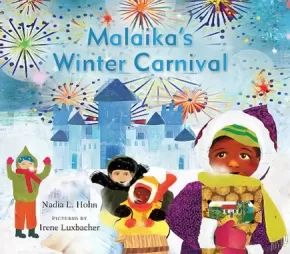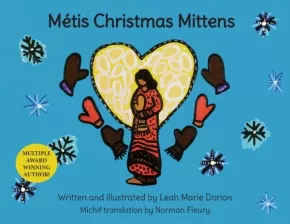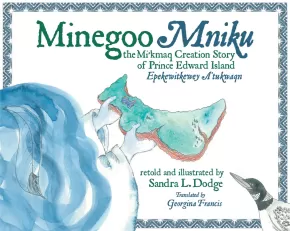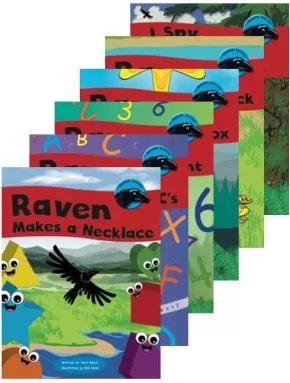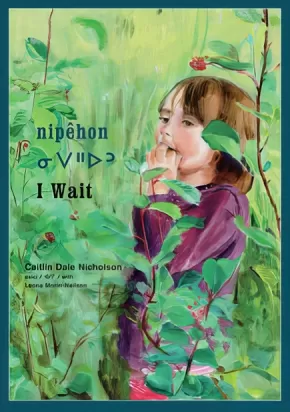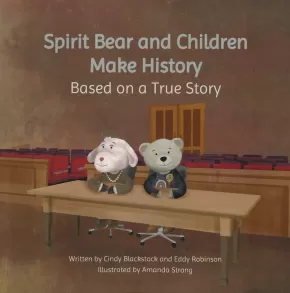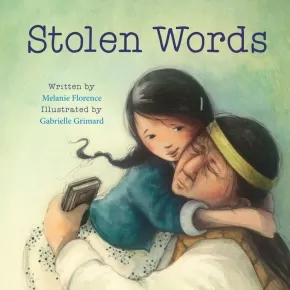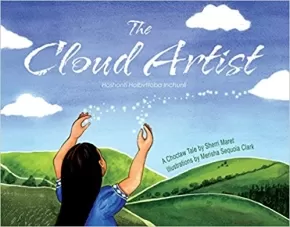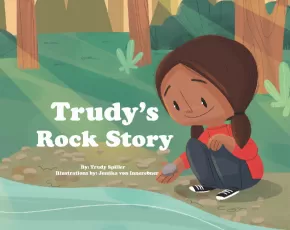
Picture Books
556
-
570
of
752 Results;
Sort By
Go To
of 51
Kisimi Taimaippaktut Angirrarijarani / Only in My Hometown
$18.95
Artists:
Format:
Hardcover
Text Content Territories:
Indigenous Canadian; Inuit;
ISBN / Barcode: 9781554988839
Synopsis:
Synopsis:
The northern lights shine, women gather to eat raw caribou meat and everyone could be family in this ode to small-town life in Nunavut, written in English and Inuktitut.
Sisters Angnakuluk Friesen and Ippiksaut Friesen collaborate on this story about what it’s like to grow up in an Inuit community in Nunavut. Every line about the hometown in this book will have readers thinking about what makes their own hometowns unique. With strong social studies curriculum connections, Kisimi Taimaippaktut Angirrarijarani / ᑭᓯᒥ ᑕᐃᒪᐃᑉᐸᒃᑐᑦ ᐊᖏᕐᕋᕆᔭᕋᓂ / Only in My Hometown introduces young readers to life in the Canadian North, as well as the Inuit language and culture.
Angnakuluk’s simple text, translated into Inuktitut and written out in syllabics and transliterated roman characters, is complemented by Ippiksaut’s warm paintings of their shared hometown.
Educator Information
Recommended Ages: 3-7.
Recommended for Grades K-2.
Curriculum Connections: Health & Daily Living, Language Arts, Social Studies.
Additional Information
24 pages | 11.00" x 8.25"
Malaika's Winter Carnival (3 in stock) ON SALE
$15.25 $18.95
Artists:
Format:
Hardcover
ISBN / Barcode: 9781554989201
Synopsis:
Synopsis:
When Malaika moves to Canada, there’s a lot to get used to, especially Carnival in the wintertime!
Malaika is happy to be reunited with Mummy, but it means moving to Canada, where everything is different. It’s cold in Québec City, no one understands when she talks and Carnival is nothing like the celebration Malaika knows from home!
When Mummy marries Mr. Frédéric, Malaika gets a new sister called Adèle. Her new family is nice, but Malaika misses Grandma. She has to wear a puffy purple coat, learn a new language and get used to calling this new place home. Things come to a head when Mummy and Mr. Frédéric take Malaika and Adèle to a carnival. Malaika is dismayed that there are no colorful costumes and that it’s nothing like Carnival at home in the Caribbean! She is so angry that she kicks over Adèle’s snow castle, but that doesn’t make her feel any better. It takes a video chat with Grandma to help Malaika see the good things about her new home and family.
Nadia L. Hohn’s prose, written in a blend of standard English and Caribbean patois, tells a warm story about the importance of family, especially when adjusting to a new home.
Reviews
"Hohn contrasts Caribbean and Canadian cultures tenderly, with deep understanding of both, and she and Luxbacher have created a sweet, immersive and loving book that will benefit both young new arrivals to a country and those just meeting them." — Kirkus Reviews, July 2017
Educator Information
Recommended for ages 3 to 7.
Correlates to the Common Core State Standards in English Language Arts:
CCSS.ELA-LITERACY.RL.K.6
With prompting and support, name the author and illustrator of a story and define the role of each in telling the story.
CCSS.ELA-LITERACY.RL.1.2
Retell stories, including key details, and demonstrate understanding of their central message or lesson.
Additional Information
36 pages | 10.00" x 9.00" | Hardcover
Métis Christmas Mittens (PB)
$17.50
Artists:
Format:
Paperback
Text Content Territories:
Indigenous Canadian; Métis;
ISBN / Barcode: 9781926795799
Synopsis:
Synopsis:
The holiday season has always been a very special time for Métis families. A family-oriented people, the Métis often didn’t have money to buy expensive presents, but instead made practical items with much love. In this spirit, award-winning author and illustrator, Leah Marie Dorion takes readers back to the Métis tradition of making mittens for loved ones. Métis Christmas Mittens is a touching ode to Métis family life is accompanied by Leah’s distinctive and evocative art.
Educator Information
Michif Translation by Norman Fleury
Format: English/Michif
Minegoo Mniku: the Mi'Kmaq Creation Story of Prince Edward Island
$13.95
Artists:
Format:
Paperback
Text Content Territories:
Indigenous Canadian; First Nations; Mi'kmaq;
ISBN / Barcode: 9781927502853
Synopsis:
Synopsis:
A long time ago, the Great Spirit created all of the sky and stars but it wasn't enough. He then made a beautiful place called Minegoo, a place so beautiful that He almost placed it amongst the stars. He decided that instead, he would place Minegoo in the most beautiful spot on earth. He summoned Kluskap and asked him to find this spot. After searching the whole world, Kluskap found the Shining Waters, the spot in the Gulf of St. Lawrence that would be home of the Mi'kmaq people created in his own image.
Review
"Minegoo would be an excellent way to introduce young people to the stories of the Mi'kmaq people." – Allison Giggey in CM Magazine
Educator Information
Recommended for ages 5-8 (kindergarten to grade 3).
This Mi'kmaq creation story is retold and illustrated by Sandra L. Dodge. Translated into Mi'kmaq by Georgina Francis.
Recommended in the Canadian Indigenous Books for Schools 2019-2020 resource list as being useful for grades K-3 in these subject areas: English Language Arts and Social Studies.
Additional Information
32 pages | 8.00" x 10.00"
Mini Raven Series Set
 $22.95
$22.95

Artists:
Format:
Paperback
Text Content Territories:
Indigenous Canadian; First Nations; Kwakwaka'wakw (Kwakiutl);
Grade Levels: Preschool; Kindergarten;
ISBN / Barcode: 9781771745987
Synopsis:
Synopsis:
The Raven Series is a set of six books written for the emergent reader and learner. Each book focuses on a specific learning intention that builds on strengthening learning with the support of an adult.
The titles and their learning intentions are:
- Raven and the Box: promotes an oral retell
- Raven and Duck: basic concepts
- Raven Can Count: number recognition
- I Spy Raven: rhyme and perspective
- Raven Learns the ABC's: letter recognition, vocabulary building
- Raven Makes a Necklace: colours and patterns
These 3"X4" books are great for young readers just learning how to read.
The Big Book Raven Series can be found in the Raven Series Category.
Additional Information
Each book has 8 pages | ISBN 9781771745987
Nimoshom and His Bus (HC) (2 in Stock)
$19.95
Artists:
Format:
Hardcover
Text Content Territories:
Indigenous Canadian; First Nations; Cree (Nehiyawak);
ISBN / Barcode: 9781553797081
Synopsis:
Synopsis:
Nimoshom loved to drive the school bus. Every day, on the way to and from school, he had something to say. Sometimes, he told the kids silly stories. Sometimes, he taught the kids a new word in Cree.
Nimoshom and His Bus introduces basic Cree words. A glossary is included in the back of the book.
Reviews
"Through accessible language and engaging visual resources, readers are introduced to basic Cree as Nimoshom responds in this language to the children who ride his bus.... The illustrator’s varying the visuals between full double spreads and single page illustrations keeps the pacing lively. Amidst a rural fall setting, with woodland animals, children, and the school bus, Nimoshom’s humorous nature shines through these gentle illustrations. At the end of this story, you just want to give Nimoshom a great big hug!"
— Anita Miettunen, CM: Canadian Review of Materials
"In this bilingual book, readers follow a bus driver picking up kids and dropping them off before and after school. Like the students on the bus, readers quickly learn that the driver's native language is Cree, and he often speaks to them in his native language. Readers learn that "Nimoshom" means "my grandfather" and that "Ekosani" means thank you" as the author (of Cree descent herself) weaves Cree words into the text, and each new spread almost feels like a gentle wave: yes, we're subtly learning new words, but it never feels strenuous or forced, rather it's calm and poetic."
— Let's Talk Picture Books
"While Penny M. Thomas' story is not a plot-driven allegory or a message-based lesson, Nimoshom and His Bus is a sweet introduction to some simple Cree words in the context of a common-place activity for many children.... Karen Hibbard who uses watercolours and pastels to create a gentle background for Nimoshom's day on his bus gives the story a grassroots mood, highly appropriate for a routine day of activity and interaction for this bus driver and his charges. It's very relatable."
— Helen Kubiw, CanLit for Little Canadians
"If you're a regular reader of AICL, you know that we're always delighted by books by Native writers--especially ones set in the present. Books like Nimoshom and His Bus provide Native children with mirrors that non-Native children find in abundance.... I highly recommend Nimoshom and His Bus! It'd be a simple thing to use other Native words in addition to--or instead of--the Cree words in the book.
— Debbie Reese, American Indians in Children's Literature
Educator Information
Recommended for ages 4-9 / grades K-4.
Recommended for Grades K-4 for the following subject areas: English Language Arts, Social Studies.
Additional Information
24 pages | 9.00" x 7.00"
nipehon / I Wait
$18.95
Artists:
Format:
Hardcover
Text Content Territories:
Indigenous Canadian; First Nations; Cree (Nehiyawak);
ISBN / Barcode: 9781554989140
Synopsis:
Synopsis:
A young child, her grandmother and mother are going out to pick wild yarrow. As Grandmother gets ready, the child and her mom wait. Grandmother leads the way to the field of blossoms, where they can finally start to pick … only now they have to wait for Mom!
The simple story, written in Cree and English and accompanied by rich acrylic illustrations, shows the patience, love and humor involved as three generations accommodate one another on a family outing. nipêhon / ᓂᐯᐦᐅᐣ / I Wait was translated by Leona Morin-Neilson, who was the inspiration for the book.
This companion volume to niwîcihâw / I Help includes a recipe for yarrow tea, known for its refreshing and soothing effects.
Educator Information
Recommended Ages: 4-7
This book is written in Cree (the Y dialect) and English. The Cree language is represented in two forms -- standard roman orthography and syllabics.
This book is part of the Nôhkom series.
Recommended for Grades K-1 for the following subject areas: English Language Arts, Indigenous Language Studies, Social Studies, Science and Nature, Visual Arts.
Authenticity Note: Leona Morin-Neilson (Métis-Cree) is a Cree teacher and the inspiration behind this book. She collaborated with the author to create this work. Leona Morin-Neilson teaches Cree at the “Power of Friendship” Aboriginial Headstart program in Prince George, British Columbia, and at the University of Northern British Columbia. She also teaches people in her community about traditional plants and how they can be used for medicinal purposes.
Because of the collaboration between Leona and the author, and Leona's Cree translation, this book has been labeled as containing Authentic Indigenous Text. It is up to readers to determine if this work is authentic for their purposes.
Additional Information
24 pages | 8.50" x 12.25"
Siku's New Friend - Nunavummi Reading Series
$7.95
Artists:
Format:
Paperback
Grade Levels: 2;
ISBN / Barcode: 9781772665604
Synopsis:
Synopsis:
Time for another canine adventure! When a new dog moves in next door, Siku and Kamik's friendship is tested.
This fun story teaches children about the importance of friendship and how to deal with feeling left out.
Educator Information
This book is part of the Nunavummi Reading Series, a Nunavut-developed series that supports literacy learning while teaching readers about the people, traditions, and environment of the Canadian Arctic. Siku's New Friend is a Level 11 book in the series.
Nunavummi Reading Series books have also been officially levelled using the Fountas & Pinnell Text Level Gradient™ Levelling System. Siku's New Friend's F&P Level is K.
Recommended for ages 5-7.
Additional Information
32 pages | 8.00" x 8.00"
Spirit Bear and Children Make History: Based on a True Story
$12.95
Artists:
Format:
Paperback
Text Content Territories:
Indigenous Canadian; First Nations;
ISBN / Barcode: 9781777009168
Synopsis:
Synopsis:
"Hello! My name is Sus Zul in the Carrier language. In English, people call me Spirit Bear. I am a proud member of the Carrier Sekani Tribal Council. I am on my way to Ottawa, Ontario, to witness a very important human rights case. Would you join me on this journey?"
When Spirit Bear's mom tells him about an important human rights case happening in Ottawa, Ontario, he makes the LONG trip (by train, his favourite way to travel) to go and watch, and to stand up for First Nations kids.
And he isn't the only one! Lots of children come too — to listen, and to show they care. Spirit Bear knows that children can change the world because he's there to see it happen.
This is the story of how kids — kids just like you — made a difference ... with a bit of help from some bears and other animals along the way!
Educator & Series Information
Spirit Bear and Children Make History tells the story of a landmark human rights case for First Nations children at the Canadian Human Rights Tribunal. Nine years after the case was filed, the Tribunal ruled that the government of Canada was racially discriminating against 165,000 First Nations children by underfunding child welfare and failing to provide equitable public services. The book contributes to the Indigenization of curriculum by centering the agency, histories and realities of First Nations children and communities. The story supports an Indigenous pedagogical approach by encouraging critical and independent thought. In keeping with Indigenous pedagogy, Spirit Bear teaches readers about Indigenous worldviews and values not through direct instruction, but through the modelling of ethical and respectful behaviour and action.
Spirit Bear and Children Make History addresses a gap in reconciliation education. There are few Canadian books for children linking reconciliation with social justice. Meaningful reconciliation in Canada requires the active engagement of children and youth. It also requires a critical and social justice approach that links the residential school system to contemporary inequities and discrimination. Educating children and families about contemporary inequities creates a foundation for change and challenges the myth that colonialism is a thing of the past.
Spirit Bear and Children Make History was written to engage a younger audience in learning about the child welfare case, and to demonstrate and affirm the powerful role of young people in the reconciliation movement. Inspired by the voices of children, and in keeping with to the Truth and Reconciliation Commission’s 94 Calls to Action, the story highlights the power of people of all ages and backgrounds to make a difference for First Nations children and families.
Recommended Grades: K-6
This book is part of the Spirit Bear series.
This book is available in French: Spirit Bear et les enfants passent à l’histoire: Basé sur une histoire vraie
Additional Information
54 pages | 8.25" x 8.25"
Stolen Words
$21.95
Artists:
Format:
Hardcover
Text Content Territories:
Indigenous Canadian; First Nations; Cree (Nehiyawak);
ISBN / Barcode: 9781772600377
Synopsis:
Synopsis:
A little girl helps her grandfather regain the language taken from him as a child.
The story of the beautiful relationship between a little girl and her grandfather. When she asks her grandfather how to say something in his language – Cree – he admits that his language was stolen from him when he was a boy. The little girl then sets out to help her grandfather find his language again. This sensitive and warmly illustrated picture book explores the intergenerational impact of the residential school system that separated young Indigenous children from their families. The story recognizes the pain of those whose culture and language were taken from them, how that pain is passed down, and how healing can also be shared.
Awards
- 2018 Ruth and Sylvia Schwartz Children's Book Winner
Reviews
"Florence's tender text soothes the harsh reality of having Native language stolen while attending one of Canada's former residential schools for Indigenous children. Grimard's equally emotive illustrations show the stark realities of the experience in symbolic images... Unforgettable. (Starred Review)" — Kirkus Reviews
"... a sobering ode to [Florence's] heritage, presented through eyes filled with love and hope... Word by word, her story—written in honor of her Cree grandfather—is a significant step toward forever healing. (Starred Review)" — Shelf Awareness
"...an emotionally charged series of interactions and memories that are pure Melanie Florence. They will astound readers and sadden them, while encouraging healing and learning without shame or anger." — CanLit for Little Canadians
"Stolen Words would be an asset to any home or school library. It is a very powerful tool to educate both Indigenous and non-indigenous readers about the long lasting effects of the residential school system." — Anishinabek News
"An emotional read, as the illustrations show mothers waving goodbye to their children and words being lost. As Grandfather revisits his native first language, the words fly back.... Recommended." — School Library Journal
"This sensitive, beautifully illustrated picture book deftly explores the inter-generational impact of Canada's residential school system... Stolen Words is unreservedly and emphatically recommended for family, preschool, elementary school, and community library picture book collections." — Midwest Book Review
Educator Information
Recommended for ages 6 to 9.
This resource is also available in French: Les mots voles
This resource is also available in English and Plains Cree as kimotinâniwiw itwêwina / Stolen Words
Stolen Words was the winning manuscript from Second Story Press' 2015 Aboriginal Writing Contest. Melanie Florence has been recognized for her ability to write about Indigenous history and culture with sensitivity and compassion, and Quebec artist Gabrielle Grimard's illustrations perfectly capture the spirit of the story.
Additional Information
24 pages | 8.50" x 8.50"
The Cloud Artist: A Choctaw Tale (1 in stock, Out of Print)
$23.95
Artists:
Format:
Hardcover
Text Content Territories:
Indigenous American; Native American; Choctaw;
ISBN / Barcode: 9781937054748
Synopsis:
Synopsis:
Born with the gift of painting with the clouds, Leona, a little Choctaw girl, uses the Oklahoma sky as her canvas to the delight of her people. When a traveling hawker hears about her talent and invites her to join the carnival, the Cloud Artist must make a decision about what kind of artist she wants to be.
Additional Information
32 pages | 10.75" x 8.75"
The Eagle's Path
 $12.95
$12.95

Artists:
Format:
Paperback
Text Content Territories:
Indigenous Canadian; First Nations; Haudenosaunee (Iroquois); Kanyen'keha:ka (Mohawk);
ISBN / Barcode: 9781771742566
Synopsis:
Synopsis:
Anna explores what it means to be Mohawk, her own identity and the identity of others as she learns to follow the Eagle’s path. She learns how her culture has taught many generations to value honesty, wisdom and courage in their day-to-day lives. Anna also learns about two-spirit people when her best friend tells her that she likes other girls. This revelation leaves her full of questions, and with support from her wise and loving mother, she understands the value in accepting everyone for who they are.
A powerful story to share with children of all ages.
Reviews
"Colour pencil sketches illustrate the story of 10-year-old Anna whose school friend Jill announces she prefers girls when the two talk about boys at their school. Anna is troubled and her parents notice Anna is unusually quiet at home. Her mother gently asks what is troubling Anna. Anna explains her confusion about her Jill’s statement that she likes girls and to Anna that is something she terms as gross. Mother explains proper terminology for female and male identity and introduces the term, two-spirit. Anna may find this new concept difficult but her mother reminds Anna of her eagle necklace and the teachings of courage, honesty and wisdom. The author has added an introductory paragraph about why she wrote this story. She also has included questions as conversation starters and an introduction of two new terms: discrimination and two-spirit for elementary classrooms." - Review from The Teaching Librarian, The Magazine of the Ontario School Library Association
Additional Information
24 Pages | ISBN: 9781771742566 | Paperback
The People of the Sea
$21.95
Format:
Paperback
Text Content Territories:
Indigenous Canadian; Inuit;
ISBN / Barcode: 9781772271386
Synopsis:
Synopsis:
When young Donald and his friends head down to the water to play, they have no idea that they are soon to encounter an arnajuinnaq ('mermaid'), one of the creatures that his elders have told him about. Terrified, the boys run back to their camp, ready to tell everyone what they have just seen. But what did they see? They can't seem to remember it clearly. It is up to Donald's grandmother to explain to them the magical creature they just encountered.
Based on the author's own childhood experiences.
Additional Information
36 pages | 9.00" x 9.00"
The People Shall Continue (6 in Stock, Out of Print)
$15.95
Artists:
Format:
Paperback
Text Content Territories:
Indigenous Canadian; Indigenous American;
ISBN / Barcode: 9780892391257
Synopsis:
Synopsis:
Many, many years ago, all things came to be.
The stars, rocks, plants, rivers, animals.
Mountains, sun, moon, birds, all things.
And the People were born.
Told in the rhythms of traditional oral narrative, this powerful telling of the history of the Native/Indigenous peoples of North America recounts their story from Creation to the invasion and usurpation of Native lands. As more and more people arrived, The People saw that the new men did not respect the land. The People witnessed the destruction of their Nations and the enslavement of their people. The People fought hard, but eventually agreed to stop fighting and signed treaties.
Many things changed and became more difficult, but The People continued to farm and create crafts. They remembered and told their children, "You are Shawnee. You are Lakota. You are Pima. You Acoma. . . . You are all these Nations of the People." The People held onto their beliefs and customs and found solidarity with other oppressed people. And despite struggles against greed, destruction of their lands, and oppression, The People persisted.
Educator Information
Renowned Acoma Pueblo poet and storyteller Simon J. Ortiz traces the progress of Native/Indigenous people of North America from the time of creation to the present.
Recommended Ages: 6-10
Additional Information
32 pages | 9.00" x 9.50"
Trudy's Rock Story
$16.99
Artists:
Format:
Paperback
Text Content Territories:
Indigenous Canadian; First Nations; Gitxsan (Gitksan);
ISBN / Barcode: 9780993869488
Synopsis:
Synopsis:
When a young girl from the Gitxsan Nation argues with her brother, she remembers the teachings of her grandmother and goes in search of a stone to share her feelings with.
This engaging First Nation’s story teaches children that it is okay to have feelings and shows them how to process and release negative thoughts.
Educator Information
This resource is also available in French: Le Caillou de Trudy
Additional Information
40 pages | 11.00" x 8.50"
Sort By
Go To
of 51




